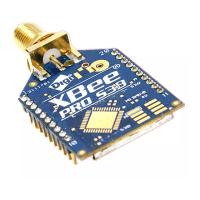Configuration and commands Serial interfacing commands
XBee®-PRO 900HP/XSC RF Modules
214
Default
0 (Disabled - channel initialization information is sent with each RF packet.)
Bytes returned
1
TT (Streaming Limit)
Sets or displays the limit on the number of bytes that a device can send before issuing a random delay.
If a device is sending a continuous stream of RF data, it inserts a delay that stops its transmission and
gives other devices time to transmit once it sends TT bytes of data. The random delay it inserts lasts
between 1 and RN + 1 delay slots where each delay slots lasts 38 ms.
You can use TT to simulate full-duplex behavior.
Binary command
0x1A (26 decimal)
Parameter range
0xFFFF (0 = disabled)
Default
0xFFFF (65535 decimal)
Bytes returned
2
Serial interfacing commands
The following commands are serial interfacing commands.
BD (Interface Data Rate)
Sets and reads the serial interface data rate (baud rate) between the device and the host. The baud
rate is the rate that the host sends serial data to the device.
When you make an update to the interface data rate, the change does not take effect until the host
issues the CN command and the device returns the OK response.
The BD parameter does not affect the RF data rate. If you set the interface data rate higher than the
RF data rate, you may need to implement a flow control configuration.
Non-standard interface data rates
When the host sends a value above 0x7D, the firmware stores the closest interface data rate
represented by the number in the BD register. For example, to set a rate of 19200 b/s, send the
following command line: ATBD4B00.
Note When using XCTU, you can only set and read non-standard interface data rates using the XCTU
Serial Console tool. You cannot access non-standard rates through the configuration section of XCTU.
When you send the BD command with a non-standard interface data rate, the UART adjusts to
accommodate the interface rate you request. In most cases, the clock resolution causes the stored

